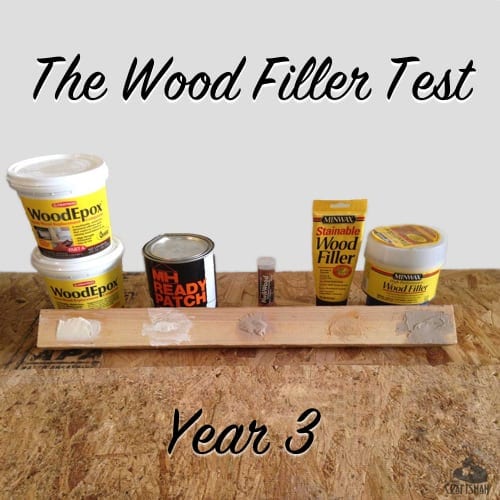 Are you ready for Year 3? I hope so, because the results are in! For three years now, I have been testing some of the most popular wood fillers and epoxies by leaving them exposed to the harsh Florida weather to help you find the best wood fillers on the shelf today.
Are you ready for Year 3? I hope so, because the results are in! For three years now, I have been testing some of the most popular wood fillers and epoxies by leaving them exposed to the harsh Florida weather to help you find the best wood fillers on the shelf today.
They have been cooked in the sun, drenched in the rain and run into by the occasional tricycle, all in the name of science.
In Year 3, there have been some interesting developments to each product that you’ll get to see below. The five products I tested here are Abatron WoodEpox, MH Ready Patch, JB Weld KwikWood, Minwax Wood Filler, Minwax High Performance Wood Filler.
The Test Conditions
To make this test as scientific as possible, I’ve outlined the rules and conditions below.
I drilled out a 1/2″ deep hole with rough edges to try to simulate a chipped or gouged board and filled the hole above the surface with filler, after which, the patches were sanded level. Here are the conditions:
- The wood fillers and epoxies were all mixed and applied according to the manufacturer’s specifications.
- The wood use was a piece of 1 1/2″ thick rough sawn cypress.
- The sample was laid horizontally outside.
- The wood and fillers/epoxies received no pre-treatment, primer or paint other than WoodEpox which was used as per the manufacturer’s instructions with LiquidWood prior to application.
All the fillers and epoxies were applied and left to cure/dry until they were ready to sand smooth. I ranked the fillers in my previous post regarding ease of application, ease of sanding, and drying time.
The sample board was left outside uncovered laying horizontally. I will qualify this by saying that all of these manufacturer’s recommend that their products be primed and painted even though I have left all of them without any primer or paint.
This test will clearly show different results than if I had painted the repairs, but I decided that seeing how a product would stand up to unprotected exposure and on a horizontal surface would show results more quickly and accurately as to which product has the greatest staying power.
WoodEpox
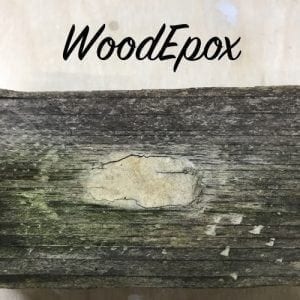 Product Info: 2-part epoxy filler
Product Info: 2-part epoxy filler
Test Results: Year 3 has brought minimal changes to this patch, yet again. The perimeter still has hairline cracks around 90% of the patch but has not grown any since last year. The patch still feels very solid in the wood and does not move at all, even when I gave it a significant push.
The algae growth appears to have decreased on the patch in Year 3, but that may have been more an issue of changing weather patterns, as we had an extremely dry April & May, even though that was followed by one of the wettest Junes on record.
The wood surrounding the patch is completely water logged currently and getting very soft with serious signs of rot occurring about an inch or so from the patch, so we’ll see how that turns out in the future as the rot approaches the patch.
Ready Patch
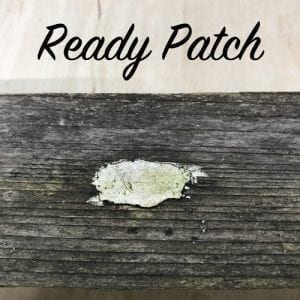 Product Info: Spackling Compound
Product Info: Spackling Compound
Test Results: This year was a complete surprise to me since Ready Patch had deteriorated so quickly in Years 1 & 2. I expected complete failure at this point, but really, there was little change from Year 2 to Year 3.
Granted Ready Patch is still exhibiting the most movement in the patch (still minimal though) of any of the materials. The edges are still raised and the center has shrunk, creating a crater in the patch though it still feels like a solid patch of spackle with no spots of softness.
This patch has the largest cracks around 100% of the perimeter and is allowing water to penetrate behind it. We’ll see what that brings in Year 4.
KwikWood
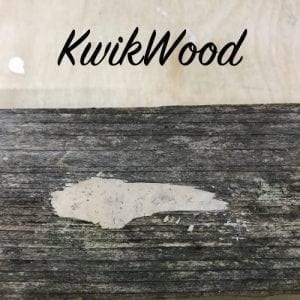 Product Info: 2-part epoxy filler
Product Info: 2-part epoxy filler
Test Results: KwikWood is still going strong, though there were slight changes from Year 2 to 3. The patch remains completely clean of dirt and seems to be impervious to algae or mold growth. The biggest change in Year 3 is that the left side of the patch has lifted up ever so slightly.
The cracking on the perimeter is still extremely fine, so if there is water getting behind the patch, then it is very minimal, but I am worried about the lifting of the patch on the left side. This may be due to swelling wood underneath, pushing it up or deterioration of the surface of the wood from exposure. At this point, it’s difficult to tell.
I still cannot detect any movement in the patch and it feels very well adhered to the wood.
Minwax Wood Filler
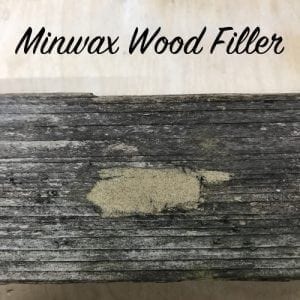 Product Info: Water-based wood filler
Product Info: Water-based wood filler
Test Results: I have complained about this filler in the past and been snooty, preferring high grade epoxies, but each year this test continues, I have to eat my words, and Year 3 is no exception.
This inexpensive water-based wood filler has continued to test better than any of the other products in my test. The patch is completely solid with minimal cracking if any. Way to go, Minwax!
I will preface Minwax Wood Filler’s stellar performance in this application to not be construed to mean that it can replace a structural epoxy like WoodEpox. Being better at filling holes in the field does not necessarily translate to patching corners or rebuilding wood elements. But for filling small to medium sized holes in wood, this filler is proving to be a serious performer that deserves credit.
Minwax High Performance Wood Filler
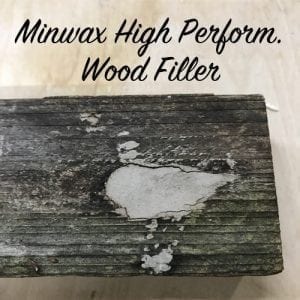 Product Info: 2-part styrene/resin filler
Product Info: 2-part styrene/resin filler
Test Results: In Year 3, the High Performance Wood Filler is continuing much the same as Year 2. There is a slight increase in perimeter cracking with nearly 95% of the perimeter cracked now. The patch is still very stable in the wood and does not move when pushed or pulled.
This is still one of the top performers when it comes to algae growth as it keeps itself relatively algae free. There appears to be a slight depression in the center that I have not noticed in past years, but it does not feel soft or weak in any area.
Final Thoughts
I don’t want anyone to feel like these products are not useful as you read this post about how they are deteriorating. I am purposely putting them under extremely harsh conditions to see how and when they fail. These will all fail at some point, as will any wood filler or epoxy. For me, it’s just a matter of seeing how they age and what to expect in the future.
July 2018 will be my next inspection of the patch stick, so we’ll see what happens in Year 4. So far, this has been an eye opening test for me to find the best products for patching wood and I hope it has helped you make some decisions for your own projects. ‘Till next year!
If you have found this test helpful consider purchasing any of these wood fillers by clicking any of the links on their names through my Amazon affiliate links to help support the blog. It costs you nothing, Amazon just gives us a little commission for sending you their way.

Founder & Editor-in-Chief
I love old houses, working with my hands, and teaching others the excitment of doing it yourself! Everything is teachable if you only give it the chance.


One more thing, this test is missing a freeze-thaw cycle. guess that’s impossible where you are, maybe simulate in a freezer?
I appreciate this experiment, but I wish there was a version where you followed the manufacturer’s instructions. Most of us want to prime and paint. It’s hard to extrapolate your findings when they being used in a manner they were not intended for.
Hey it’s August 2018 now, looking forward to your year 4 review!!
Already posted! https://thecraftsmanblog.com/wood-filler-epoxy-test-year-4/
How do you think they would perform in an area where there is freezing every winter?
For wood repairs, structural and other applications, I have had great success over the years with both ART epoxy as well as West System. My first repair with West Systems was dry rot on several exterior window sills. 25 years later, they are still just like the day they were repaired. The sills are exposed to direct sun as well.
Very good information Scott. I have been involved in developing wood repair materials for over 25 years. To my knowledge, my newest product: Dura-Fix Slow Cure is the only material available with 10 year performance guarantee.
http://www.nxtgensys.com
Scott – Any thoughts on the best one to use on an exterior oak door that has 1/16″ or 1/32″ or so crack running the length of the middle panel, around 3-4 feet long? I wanted to fill the hole, sand it, stain it to match color and then use a water based poly on top for protection of the door. I plan to poly it every 1 or 2 years to maintain protection. Minwax stainable wood filler? Door is a dark stain, covered by a large overhang but does get some indirect sunlight during nicer months…..
Scott, in your post “The 7 Best Products to Patch Wood” you recommended Durhan’s Water Putty but then did not test it in the 2- and 3-year tests. Is this because Durham’s product is designed for interior use and the tests were conducted outdoors?
Really appreciate all the information contained in those three posts. Decided to sign up for your newsletter as well.
Thank you,
Bruce Codding
Looks like most of these fillers and patches are still going strong! However, you must remember that none of these are meant to be left unpainted. With the appropriate primer and paint, many of these will last for years to come. I used the Minwax High Performance Wood Filler on the first house I ever restored in 1994 (dry rot on a window sill). Twenty-three years later, it’s still performing well! Proper prep and finish have a lot to do with how well products perform.
Absolutely!
Excellent information and very helpful. Thanks Scott.